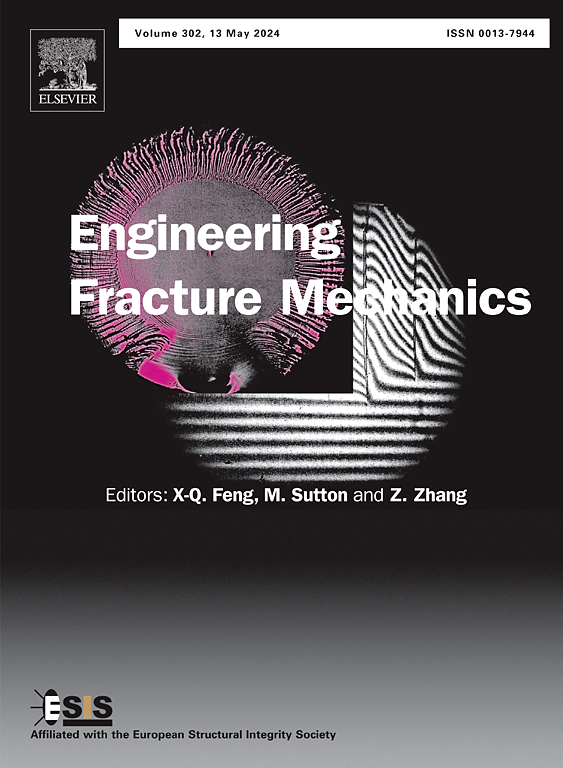研究疲劳和氢脆条件下裂纹尖端行为和预测裂纹生长率的变形-扩散交互模型
IF 4.7
2区 工程技术
Q1 MECHANICS
引用次数: 0
摘要
氢被认为是一种更清洁、更可持续的能源,因为与化石燃料相比,氢蕴含丰富的能量,燃烧时不会产生任何废气。然而,据报道,暴露在气态氢中的金属材料会因氢脆而导致机械性能的长期退化,从而导致疲劳状态下裂纹的加速生长。本文建立了一个粘弹性变形-扩散交互模型,以研究氢脆条件下镍基超级合金的疲劳裂纹增长行为。在该模型中,循环变形由粘弹性构成模型描述,而氢扩散则由修正形式的菲克第一扩散定律模拟,该定律可解决由静水压力梯度驱动的氢扩散问题。特别是,在氢扩散模型中考虑了滞留氢,它取决于可扩散氢浓度和非弹性应变。该模型还通过考虑氢浓度对各向同性硬化演变和应变状态的影响,描述了氢浓度对机械变形的影响。因此,该模型对受到疲劳和氢气侵蚀的紧凑拉伸试样中的裂纹尖端进行了循环变形和氢气扩散之间的相互作用研究,结果表明其与加载频率和应力强度因子范围都有很大关系。随后,针对疲劳裂纹生长预测提出了一个双参数准则,该准则考虑了循环变形和氢扩散的贡献。就疲劳和氢脆条件下的裂纹生长率而言,预测结果与实验数据非常吻合。本文章由计算机程序翻译,如有差异,请以英文原文为准。
A deformation-diffusion interactive model to study crack-tip behaviour and predict crack growth rate under fatigue and hydrogen-embrittlement conditions
Hydrogen is accepted as a cleaner and more sustainable energy source, since it carries abundant energy and does not produce any effluent gas from burning when compared to fossil fuels. However, long-term degradation in mechanical properties, attributed to hydrogen embrittlement, is reported for metallic materials exposed to gaseous hydrogen, leading to accelerated crack growth behaviour under fatigue. In this paper, a visco-plastic deformation-diffusion interactive model is developed to study fatigue crack growth behaviour in a nickel-based superalloy under hydrogen-embrittlement condition. In the model, cyclic deformation is described by visco-plasticity constitutive model, while hydrogen diffusion is simulated by a modified form of Fick’s first law of diffusion which can address hydrogen diffusion driven by the hydrostatic stress gradient. In particular, trapped hydrogen, expressed as dependent on both diffusible hydrogen concentration and inelastic strain, is considered in the modelling of hydrogen diffusion. The model also describes the effects of hydrogen concentration on mechanical deformation by considering its influence on the evolution of isotropic hardening as well as on the strain state. Interaction between cyclic deformation and hydrogen diffusion is therefore studied for a crack tip in a compact tension specimen subjected to fatigue and hydrogen attack, showing a strong dependency on both loading frequency and stress intensity factor range. Subsequently, a two-parameter criterion is proposed for fatigue crack growth prediction, which accounts for the contributions of both cyclic deformation and hydrogen diffusion. The predictions show a good agreement with experimental data in terms of crack growth rate under fatigue and hydrogen-embrittlement conditions.
求助全文
通过发布文献求助,成功后即可免费获取论文全文。
去求助
来源期刊
CiteScore
8.70
自引率
13.00%
发文量
606
审稿时长
74 days
期刊介绍:
EFM covers a broad range of topics in fracture mechanics to be of interest and use to both researchers and practitioners. Contributions are welcome which address the fracture behavior of conventional engineering material systems as well as newly emerging material systems. Contributions on developments in the areas of mechanics and materials science strongly related to fracture mechanics are also welcome. Papers on fatigue are welcome if they treat the fatigue process using the methods of fracture mechanics.

 求助内容:
求助内容: 应助结果提醒方式:
应助结果提醒方式:


